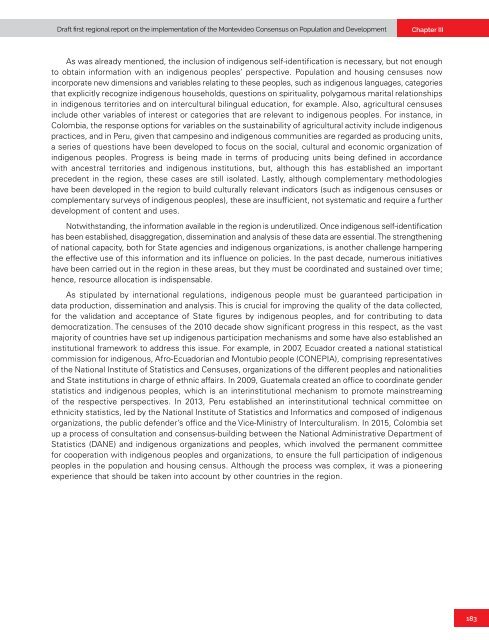Draft first regional report on the implementation of the Montevideo Consensus on Population and Development
This draft report seeks to give an account of progress in the implementation of the priority measures of the Montevideo Consensus on Population and Development in the region, as well as the differences between countries in terms of the degree of implementation. By highlighting relevant national experiences, it also seeks to facilitate the exchange of good practices among countries so that they can benefit from each other in their efforts to advance the implementation of the actions of the Montevideo Consensus.
This draft report seeks to give an account of progress in the implementation of the priority measures of the Montevideo Consensus on Population and Development in the region, as well as the differences between countries in terms of the degree of implementation. By highlighting relevant national experiences, it also seeks to facilitate the exchange of good practices among countries so that they can benefit from each other in their efforts to advance the implementation of the actions of the Montevideo Consensus.
You also want an ePaper? Increase the reach of your titles
YUMPU automatically turns print PDFs into web optimized ePapers that Google loves.
<str<strong>on</strong>g>Draft</str<strong>on</strong>g> <str<strong>on</strong>g>first</str<strong>on</strong>g> <str<strong>on</strong>g>regi<strong>on</strong>al</str<strong>on</strong>g> <str<strong>on</strong>g>report</str<strong>on</strong>g> <strong>on</strong> <strong>the</strong> implementati<strong>on</strong> <strong>of</strong> <strong>the</strong> M<strong>on</strong>tevideo C<strong>on</strong>sensus <strong>on</strong> Populati<strong>on</strong> <strong>and</strong> <strong>Development</strong><br />
Chapter III<br />
As was already menti<strong>on</strong>ed, <strong>the</strong> inclusi<strong>on</strong> <strong>of</strong> indigenous self-identificati<strong>on</strong> is necessary, but not enough<br />
to obtain informati<strong>on</strong> with an indigenous peoples’ perspective. Populati<strong>on</strong> <strong>and</strong> housing censuses now<br />
incorporate new dimensi<strong>on</strong>s <strong>and</strong> variables relating to <strong>the</strong>se peoples, such as indigenous languages, categories<br />
that explicitly recognize indigenous households, questi<strong>on</strong>s <strong>on</strong> spirituality, polygamous marital relati<strong>on</strong>ships<br />
in indigenous territories <strong>and</strong> <strong>on</strong> intercultural bilingual educati<strong>on</strong>, for example. Also, agricultural censuses<br />
include o<strong>the</strong>r variables <strong>of</strong> interest or categories that are relevant to indigenous peoples. For instance, in<br />
Colombia, <strong>the</strong> resp<strong>on</strong>se opti<strong>on</strong>s for variables <strong>on</strong> <strong>the</strong> sustainability <strong>of</strong> agricultural activity include indigenous<br />
practices, <strong>and</strong> in Peru, given that campesino <strong>and</strong> indigenous communities are regarded as producing units,<br />
a series <strong>of</strong> questi<strong>on</strong>s have been developed to focus <strong>on</strong> <strong>the</strong> social, cultural <strong>and</strong> ec<strong>on</strong>omic organizati<strong>on</strong> <strong>of</strong><br />
indigenous peoples. Progress is being made in terms <strong>of</strong> producing units being defined in accordance<br />
with ancestral territories <strong>and</strong> indigenous instituti<strong>on</strong>s, but, although this has established an important<br />
precedent in <strong>the</strong> regi<strong>on</strong>, <strong>the</strong>se cases are still isolated. Lastly, although complementary methodologies<br />
have been developed in <strong>the</strong> regi<strong>on</strong> to build culturally relevant indicators (such as indigenous censuses or<br />
complementary surveys <strong>of</strong> indigenous peoples), <strong>the</strong>se are insufficient, not systematic <strong>and</strong> require a fur<strong>the</strong>r<br />
development <strong>of</strong> c<strong>on</strong>tent <strong>and</strong> uses.<br />
Notwithst<strong>and</strong>ing, <strong>the</strong> informati<strong>on</strong> available in <strong>the</strong> regi<strong>on</strong> is underutilized. Once indigenous self-identificati<strong>on</strong><br />
has been established, disaggregati<strong>on</strong>, disseminati<strong>on</strong> <strong>and</strong> analysis <strong>of</strong> <strong>the</strong>se data are essential. The streng<strong>the</strong>ning<br />
<strong>of</strong> nati<strong>on</strong>al capacity, both for State agencies <strong>and</strong> indigenous organizati<strong>on</strong>s, is ano<strong>the</strong>r challenge hampering<br />
<strong>the</strong> effective use <strong>of</strong> this informati<strong>on</strong> <strong>and</strong> its influence <strong>on</strong> policies. In <strong>the</strong> past decade, numerous initiatives<br />
have been carried out in <strong>the</strong> regi<strong>on</strong> in <strong>the</strong>se areas, but <strong>the</strong>y must be coordinated <strong>and</strong> sustained over time;<br />
hence, resource allocati<strong>on</strong> is indispensable.<br />
As stipulated by internati<strong>on</strong>al regulati<strong>on</strong>s, indigenous people must be guaranteed participati<strong>on</strong> in<br />
data producti<strong>on</strong>, disseminati<strong>on</strong> <strong>and</strong> analysis. This is crucial for improving <strong>the</strong> quality <strong>of</strong> <strong>the</strong> data collected,<br />
for <strong>the</strong> validati<strong>on</strong> <strong>and</strong> acceptance <strong>of</strong> State figures by indigenous peoples, <strong>and</strong> for c<strong>on</strong>tributing to data<br />
democratizati<strong>on</strong>. The censuses <strong>of</strong> <strong>the</strong> 2010 decade show significant progress in this respect, as <strong>the</strong> vast<br />
majority <strong>of</strong> countries have set up indigenous participati<strong>on</strong> mechanisms <strong>and</strong> some have also established an<br />
instituti<strong>on</strong>al framework to address this issue. For example, in 2007, Ecuador created a nati<strong>on</strong>al statistical<br />
commissi<strong>on</strong> for indigenous, Afro-Ecuadorian <strong>and</strong> M<strong>on</strong>tubio people (CONEPIA), comprising representatives<br />
<strong>of</strong> <strong>the</strong> Nati<strong>on</strong>al Institute <strong>of</strong> Statistics <strong>and</strong> Censuses, organizati<strong>on</strong>s <strong>of</strong> <strong>the</strong> different peoples <strong>and</strong> nati<strong>on</strong>alities<br />
<strong>and</strong> State instituti<strong>on</strong>s in charge <strong>of</strong> ethnic affairs. In 2009, Guatemala created an <strong>of</strong>fice to coordinate gender<br />
statistics <strong>and</strong> indigenous peoples, which is an interinstituti<strong>on</strong>al mechanism to promote mainstreaming<br />
<strong>of</strong> <strong>the</strong> respective perspectives. In 2013, Peru established an interinstituti<strong>on</strong>al technical committee <strong>on</strong><br />
ethnicity statistics, led by <strong>the</strong> Nati<strong>on</strong>al Institute <strong>of</strong> Statistics <strong>and</strong> Informatics <strong>and</strong> composed <strong>of</strong> indigenous<br />
organizati<strong>on</strong>s, <strong>the</strong> public defender’s <strong>of</strong>fice <strong>and</strong> <strong>the</strong> Vice-Ministry <strong>of</strong> Interculturalism. In 2015, Colombia set<br />
up a process <strong>of</strong> c<strong>on</strong>sultati<strong>on</strong> <strong>and</strong> c<strong>on</strong>sensus-building between <strong>the</strong> Nati<strong>on</strong>al Administrative Department <strong>of</strong><br />
Statistics (DANE) <strong>and</strong> indigenous organizati<strong>on</strong>s <strong>and</strong> peoples, which involved <strong>the</strong> permanent committee<br />
for cooperati<strong>on</strong> with indigenous peoples <strong>and</strong> organizati<strong>on</strong>s, to ensure <strong>the</strong> full participati<strong>on</strong> <strong>of</strong> indigenous<br />
peoples in <strong>the</strong> populati<strong>on</strong> <strong>and</strong> housing census. Although <strong>the</strong> process was complex, it was a pi<strong>on</strong>eering<br />
experience that should be taken into account by o<strong>the</strong>r countries in <strong>the</strong> regi<strong>on</strong>.<br />
183


















